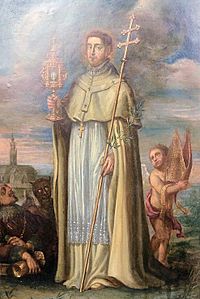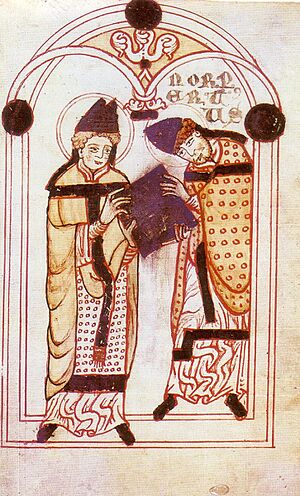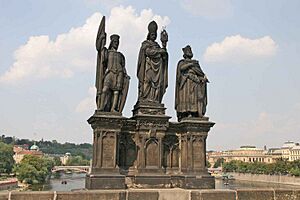Norbert of Xanten facts for kids
Quick facts for kids SaintNorbert of Xanten O. Praem |
|
|---|---|

Saint Norbert of Xanten, with the St. Michael's Abbey, Antwerp
|
|
| Bishop and Confessor | |
| Born | c. 1075 Gennep, Archbishopric of Cologne, Holy Roman Empire |
| Died | 6 June 1134 (aged 58–59) Magdeburg, Archbishopric of Magdeburg |
| Venerated in | Catholic Church |
| Canonized | 28 July 1582, Rome by Pope Gregory XIII |
| Feast | 6 June |
| Attributes | monstrance; cross with two beams |
| Patronage | Kingdom of Bohemia (now Czech Republic), invoked during childbirth for safe delivery; Magdeburg |
Norbert of Xanten (born around 1075, died June 6, 1134) was an important leader in the Catholic Church. He was a bishop and started a special group of priests called the Premonstratensian order. Today, he is honored as a saint. Pope Gregory XIII officially made him a saint in 1582. You can even see a statue of Saint Norbert in St. Peter's Square in Rome.
Contents
Norbert's Early Life as a Priest
Norbert was known for his very strict way of life. He tried to bring changes to the priests in Xanten, but they did not agree with his new ideas. In 1118, they spoke against him at a meeting called the Council of Fritzlar.
After this, Norbert decided to give up his church position. He sold everything he owned and gave the money to people in need. He then visited Pope Gelasius II, who gave him permission to travel and preach. Norbert traveled through areas that are now parts of Germany, Belgium, the Netherlands, and France. People believed he performed many miracles.
As he traveled, Norbert saw that many priests felt alone and discouraged. They often felt that the official Church did not care much about them.
In Paris, Norbert saw how the Canons of St. Victor lived. They followed strict spiritual rules. He also learned about the Cistercian monks at Clairvaux and Citeaux. They had made big changes to how monasteries were run. The Cistercians had a system that connected many monasteries, giving them some central power. These ideas greatly influenced Norbert's future work.
Founding the Prémontré Order

In October 1119, at a meeting called the Council of Reims, Pope Calixtus II asked Norbert to start a new religious order. This order would be in the Diocese of Laon in France. On Christmas Day, 1120, Norbert officially started the Canons Regular of Prémontré.
For their way of life, Norbert chose the Rule of St. Augustine. This rule was common for groups of priests. He also added some customs from the Cistercians. Later, Norbert's helper, Abbot Hugh of Fosse, added even more Cistercian customs. The main idea was that active priests needed a quiet and spiritual place to live. This was the purpose of the abbey's rules.
Norbert chose a valley in the Forest of Coucy for his new order. This land was given to him by Barthélemy de Jur, the Bishop of Laon. The place was named Prémontré. Among his first thirteen followers were Hugh of Fosses and seven students from a famous school. By the next year, the group had grown to 40 members. They all made their promises, and the Order of Canons Regular of Prémontré began.
At first, the community lived in simple huts made of wood and clay. These huts were set up like a camp around a small chapel. Soon, they built a larger church and a monastery. Many more religious people joined them. In 1125 or 1126, Pope Honorius II officially approved the rules for the new order.
Norbert gained followers in many countries, including Germany, France, Belgium, and Hungary. New houses for his order were started in many places. Count Theobald II of Champagne wanted to join the order. But Norbert advised him to stay a regular person and get married. Norbert gave Theobald some rules and a white cloth to wear. This is how the Third Order of St. Norbert began in 1122.
Norbert continued to preach in France, Belgium, and Germany. He successfully fought against a false teaching about the Eucharist in Antwerp. Because of this, Norbert is called the "Apostle of Antwerp."
In 1126, Pope Honorius II made Norbert the Archbishop of Magdeburg. There, he put his strict rules into practice. Some people tried to hurt him because he was reforming the priests. He also helped protect the Church's rights against powerful rulers.
In 1130, there was a disagreement about who should be the Pope. Norbert supported Pope Innocent II and went against another leader. In his last years, Norbert was an important advisor to Lothair II, the Holy Roman Emperor. He convinced the Emperor to lead an army to Rome in 1133. This helped Innocent become Pope again.
Honoring Saint Norbert

When Norbert died in Magdeburg on June 6, 1134, two groups of priests wanted his body. The Emperor decided that Norbert should be buried in the Norbertine Abbey.
Later, in 1524, Magdeburg became a Protestant city. For many years, the Abbey of Strahov in Prague tried to get Norbert's body. Finally, after some battles, the abbot of Strahov was able to claim the body. On May 2, 1627, Norbert's body was brought to Prague. It is still there today, displayed in a special glass tomb.
Norbert was officially made a saint by Pope Gregory XIII in 1582. His statue stands above the colonnade in St. Peter's Basilica in Rome.
Norbert's Legacy Today
The Premonstratensian (or Norbertine) Canons are active today in many parts of the world. This includes Europe, the United States, Canada, the United Kingdom, South America, Africa, India, and Australia. They work in education, help in churches, and do youth work.
St. Norbert College in De Pere, Wisconsin, was the first college started by the Norbertine order. This college also has a special center for Norbertine Studies.
See also
 In Spanish: Norberto de Xanten para niños
In Spanish: Norberto de Xanten para niños
- Catholic Church in Germany
- List of Catholic saints
- Saint Norbert of Xanten, patron saint archive

